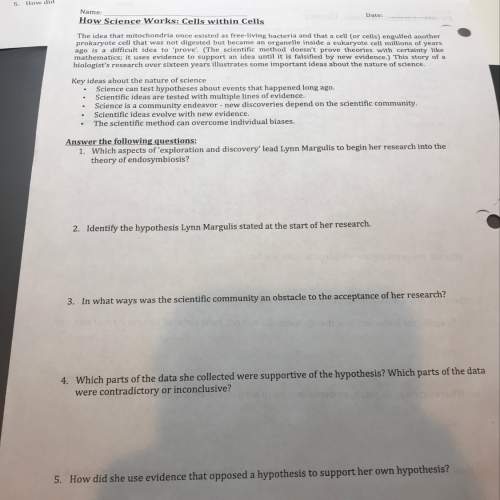
Biology, 28.09.2019 12:30 sreyasusanbinu
Rosie is a chubby infant. her doctors observed that she has slanting eyes and a flatted nose, unusual to her ethnic group. her hands are broad and stubby. her mother told the doctors that she is achieving her milestones at a delayed time interval. what do you think rosie is most likely suffering from?
tay sachs
klinefelter disease
huntington disease
neural tube defect
down syndrome

Answers: 1


Other questions on the subject: Biology

Biology, 21.06.2019 19:50, Chapo3760
Consider the last statement in the prompt: "people take such environmental factors into account in their choices when deciding where to live." do all people have a choice as to where they live? what factor plays a key role in this decision and may therefore play a large role in determining quality of life?
Answers: 3

Biology, 21.06.2019 20:00, terriblexsiren
The images show the wings of a bat and a bee. from this evidence, what can you conclude about the evolutionary relationship between these organisms? a. the wing structures of the bat and the bee are different, indicating they didn’t inherit wings from a common ancestor. b. the wing structures of the bat and the bee are different, indicating they inherited wings from a common ancestor. c. the functions of bat wings and bee wings are the same, indicating they obtained wings from a common ancestor. d. the functions of bat wings and bee wings are different, indicating they didn’t obtain wings from a common ancestor.
Answers: 3

Biology, 21.06.2019 20:30, chozz2783
Match the descriptions / definitions with the term they best describe 1. three dimensional relationship of the different polypeptide chains in a multisubunit protein or protein complex 2. common folding pattern in proteins in which a linear sequence of amino acids folds into a right-handed coil stabilized by internal hydrogen-bonding between polypeptide backbone atoms. 3. the amino acid sequence of a protein 4. a region on the surface of a protein that can interact with another molecule through noncovalent bonding. 5. three-dimensional arrangement of alpha-helices and beta-sheets within a single polypeptide, typically stabilized by a variety of noncovalent bonds, including ionic and hydrogen bonds, and nonpolar interactions / hydrophobic force. 6. the chain of repeating carbon and nitrogen atoms, linked by peptide bonds, in a protein. 7. common structural motif in proteins in which different sections of the polypeptide chain run alongside each other and are joined together by hydrogen bonding between atoms of the polypeptide backbone. 8. portion of a polypeptide chain that has a discrete tertiary structure of its own and can often fold independently of the rest of the chain 9. regular local folding patterns in a protein, including alpha-helix and beta-sheet a. primary structure b. beta-sheet c. protein d. coiled-coil e. polypeptide backbone f. secondary structure g. side chain h. tertiary structure i. binding site j. alpha-helix k. quaternary structure l. protein domain
Answers: 2

Biology, 22.06.2019 06:00, ajbrock1004
Other than earth, is also known to have magnetic pole reversal? a: venus b: mars c: earths moon d: the sun
Answers: 1
You know the right answer?
Rosie is a chubby infant. her doctors observed that she has slanting eyes and a flatted nose, unusua...
Questions in other subjects:

Mathematics, 19.03.2021 18:10

Mathematics, 19.03.2021 18:10

Mathematics, 19.03.2021 18:10


Mathematics, 19.03.2021 18:10

Mathematics, 19.03.2021 18:10



Mathematics, 19.03.2021 18:10




